Is quartzite really, really porous...or not?
My husband was talking to the owner of one of the many stone yards we'll be visiting tomorrow. He was told that quartzite is "really, really, really porous".
We're going to look at Quartzite Bianca (same as Sochi's, different name). Researching it seems to suggest that there's a huge variation between types of quartzite and their porosity.
Anyone have any idea which ones are the MOST porous, and which ones the LEAST? Husband is freaked out and wants to get quartz...but my heart is set on quartzite.
Comments (43)
sochi
12 years agolast modified: 9 years agoQuartzite isn't porous, but it must be sealed properly. My fabricator had worked with something he called quartzite in the past that was soft. He admitted once he fabricated my counters that there were clearly different kinds of quartzite.
My quartzite was called Q Bianca, most here know it as Luce di Luna though. Many of us have it and it is very nearly indestructible when sealed.
If it really is Q Bianca you should be fine. Ask your guy if he has worked with this specific stone yet - I bet he hasn't. This stone seems to have only become available here over the past few years and many just havent worked with yet. Good luck and take pictures!
breezygirl
12 years agolast modified: 9 years agoIt's difficult to make generalizations about every variety of stone within one classification. Many stone yards even disagree as to what is marble vs quartzite vs granite. Every quartzite isn't the same, even within the same named variety. From what I can tell, quartzites aren't generally porous and don't generally etch. The best way to tell about the qualities stone you're considering is to get a sample and experiment. Sometimes yards won't give out chunks of the expensive or rare stones though.
I don't recall reading about any that are very porous. The ones I've seen here the most are White Princess, Super White, and Madre Perola. Cloudswift has a stunning one also, but I can't remember the name. No one seems to have trouble with them so I'm guessing they aren't porous if sealed properly. Have fun looking tomorrow!
Related Professionals
Ossining Kitchen & Bathroom Designers · Philadelphia Kitchen & Bathroom Designers · Piedmont Kitchen & Bathroom Designers · Queen Creek Kitchen & Bathroom Designers · Town 'n' Country Kitchen & Bathroom Designers · Holden Kitchen & Bathroom Remodelers · Bay Shore Kitchen & Bathroom Remodelers · Beverly Hills Kitchen & Bathroom Remodelers · Brentwood Kitchen & Bathroom Remodelers · Gardner Kitchen & Bathroom Remodelers · League City Kitchen & Bathroom Remodelers · Luling Kitchen & Bathroom Remodelers · Phoenix Kitchen & Bathroom Remodelers · Portage Kitchen & Bathroom Remodelers · Rancho Cordova Tile and Stone Contractorsdeeageaux
12 years agolast modified: 9 years agoQuartzite isn't porous, but it must be sealed properly.
That is oxymoronic.
The only reason to seal a stone is because it is porous.
I guess sandstone isn't porous if sealed properly.
And I have sandstone coasters.
sochi
12 years agolast modified: 9 years agoI think all stone needs to be sealed doesn't it - light granites, etc? I said that it needed to be sealed properly as some people on GW had problems with water stains or absorption with a certain kind of sealant. There was a long thread on this a few months back. I think the light quartzites demand a silicone based sealant. I've posted the link below, my apologies if I used the wrong term.
Here is a link that might be useful: previous thread
brickeyee
12 years agolast modified: 9 years ago"I think all stone needs to be sealed doesn't it - light granites, etc?"
No.
Some stones will not absorb much of anything, and 'sealing' just leaves an easily damaged film on the surface,
neilaz
12 years agolast modified: 9 years agoNo you didn't use the wrong term. Some people are just morons
davidro1
12 years agolast modified: 9 years agohi lisa0527,
good idea to get other opinions. While DH and you are both suffering from salesmen's pitch or cant. Some sales people play with you while you suffer.
get your hands on a small sample piece of the stone you like. Play with it at home and subject it to damage. Once you do that you will know whether you want it or not.
clg7067
12 years agolast modified: 9 years agoWhat some stone dealers are calling Quartzite, really isn't. So, "depends".
Real quartzite is very hard. I have Quartzite tile in my entry and it's bullet proof.
There was a thread a long time ago the explained which are really quartzite and which are basically marble.
pamike1
12 years agolast modified: 9 years agoMy luce de luna countertop was installed just this morning. I love it, looks great, *but* I must say the stone *is* very porous. In our enthusiasm to use the counter to spread out cold cuts and make sandwiches on the countertop, a lid from the pickle jar left a ring on the surface (oh my, oh s..t). My husband pointed it out right away and in my rush to clean it up, I used a wet sponge to wipe it away and he says look.... it's getting worse(oh my)! The water had soaked into the stone making it appear darker, but I'm happy to say disappeared after it dried about 15mins later. I called the fabricator and are waiting to hear if we should have the sealer they used replaced with 511 Porous Plus or GrandQuartz 413S, as recommended here. Doesn't sound like a big deal but it nearly gave me a heart attach (palps at the least)! The install wasn't without other problems, but I won't bore with details here
salmon_slayer
12 years agolast modified: 9 years agoours is bullet proof. We would do it again.
From finished kitchen
Here is a link that might be useful: finished kitchen
kellycal
12 years agolast modified: 9 years agoI am just encountering this same type of question. We just had superwhite/moon night quartzite installed in our kitchen and it didn't take long for me to realize it is very soft. scratches quite easily (compared to our previous experience ub with uba tuba granite counters.) it also etches very easily, which i am researching here. i don't know what sealant was used but i need to find out if a different sealer will work better than what we have. what we have now is not good - we've only been living in this kitchen for a few months - spots, ring marks, actual shape of my cheese grater etched on there. very confused!
Cloud Swift
12 years agolast modified: 9 years agoQuartzite is always hard. Sochi, if your fabricator fabricated something that he thought was quartzite and found it to be soft, then it was mis-identified. Quartzite is made almost entirely of quartz which is harder than granite. There is also orthoquartzite which is partially metamorphized sandstone - the grains are still distinct so that may have a tendency to crumble and that might be what he was working on or it may have been another stone entirely. Quartzite has been fully metamorphized and recrystalization has eliminated the grain boundaries so it is very hard and very stable.
Porosity is a different characteristic from hardness. According to one website, different quartzites can vary a lot in porosity from less porous than any granite to more porous. Our quartzite is non-porous and bullet-proof.
lisa0527
Original Author12 years agolast modified: 9 years agoSaw the quartzite that's really, really porous today. It was called Bianco, but didn't look like anything I've seen here... a very plain stone with mostly white and gray, little action or movement. It was honed, and not so appealing. The owner seemed to know what he was talking about and we had a long talk about resins and sealing quartzites and granites.He stands by his statement that Bianco quartzite is super porous.
We talked about the Madre Perla I saw ealier in the week had a very strange almost plasticy orangish film on one edge, which is apparently poorly/thickly applied resin. Makes me worry about the White Pearl I saw in the same yard, so I'll have to go back and check the slabs carefully.
Even more confusing...I saw the most AMAZING slab of leathered Golden Lightning which blew me away! I swear, if I'd had to decide then and there I would have gone for it. Feeling calmer now and back to the white/cherry cabs and White Pearl. Who knew it would be so hard to find a stone!
sochi
12 years agolast modified: 9 years agoI think you're exactly right cloud shift, different quartzites must vary in porosity. I'm sorry that the slab you saw wasn't that great lisa, good luck with the search. That Golden Lightning sounds incredible!
It sounds like what is called quartzite bianca there isn't the same as in some other places. It would make our lives a great deal easier if there was some kind of consensus on naming stone!
Perhaps my quartzite bianca is porous - but with 18 months use now, it is certainly non-porous and bullet-proof when properly sealed. Cloud swift, have you ever re-sealed your stone?
mrshanson1
12 years agolast modified: 9 years agoI had reserved two slabs of La Dolce Vita quartzite last week- it was soo beautiful! I have been on GW for awhile, and did not hear anyone mention this stone before. It was white with light tan lines- similar to marble, but tan lines instead of gray lines of marble. This was my instant love. However, here comes the price- it was over $10 thousand for everything.
Sometimes you have to step back, and realize that something this beautiful comes with more than a high price. I dont want to worry every time I open a pickle jar, or my kids spill grape juice.
Is this quartzite simply too complicated? I dont have the answers, or the money. Regular quartz or granite may be the more simpler answers....
My two cents..
brickeyee
12 years agolast modified: 9 years agoThe classification of stone type by the industry is a bit of a joke (second only to some of the naming).
For a long time anything harder than marble (requires carbide tooling) that required diamond tooling was called 'granite' irrespective of the actual type of stone.
In geology stones can have rather tightly defined characteristics, in some cases down to chemical formulas.
Others stone types do not have a single formula because they are not chemically consistent.
In many cases it is the inclusions in specific stones that make the attractive, while making them not clearly defined.
Think of 'granite with inclusions of X.'
davidro1
12 years agolast modified: 9 years agothank you!
"... classification of stone type .... the naming..." = a sham, which they have to keep, because there is nothing better yet.
Cloud Swift
12 years agolast modified: 9 years agokellycal, a sealer will stop staining because it will fill in the pores of the stone. It doesn't cover the surface so it won't prevent etching. If your stone is quartzite, it won't etch. If it is etching, it isn't quartzite regardless of what the stone yard called If it is soft enough to scratch easily, it isn't quartzite. It sounds like you may have been sold a stone that is closer to marble.
Lisa, porous can be taken care of with sealing. Etching or scratching would be more of a concern - sealing won't change those. Quartzite shouldn't etch and it should take something about as hard as diamonds to scratch it. If you are interested in particular slabs, try getting a sample from the slabs to test. Put kitchen acids like lemon juice or vinegar on it for a few hours or over night. If you want to check for porosity, leave some red wine on it and see if stains. If something is very porous, just putting water on it will leave a water mark until the water evaporates. It means that the stone will need to be sealed.
Sochi, I've never resealed my quartzite. It has been in for 5 years. I tested a sample of it before we bought it and nothing stained. It probably didn't need the original sealing.
slush1422
12 years agolast modified: 9 years agoJust wanted to post my recent experience. We had Moon Night Granite (our place called it granite but others call it Super White Quartzite), installed a few weeks ago. It's also considered a "honed" finish - but it's NOT smooth and I thought honed was always smooth. It's soft to the touch because of the matte finish, and has a lot of really cool texture along the veining. Our fabricator had never worked with it before, but he did say it was a very hard stone for him to cut. Harder than any other granite he's worked with. I sealed it myself with the DuPoint sealer you get from Lowes. We left a red wine spill overnight without knowing and it wiped right up the next day leaving no stain at all. It also has not etched at all. At first I was completely paranoid about it, because I could not find a single person who has a counter-top like mine (with the matte finish and texture) so I was treating it like marble, but after seeing how the red wine cleaned up and not having a single dark water spot issue, I'm thinking we will not have a problem with it.
From Moon Night Granite Install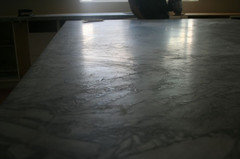 From Berta Install
From Berta Install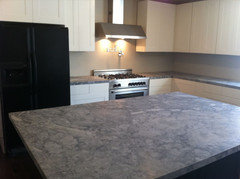
lisa0527
Original Author12 years agolast modified: 9 years agoThat roughness/texture you have on your counters is what the distributor told us to expect if we went with honed. He said it was because of the variation in hardness within the slab, with some inclusions/veins being really hard, and therefore harder to hone. Glad to hear yours is holding up so well. Do you know if it had a resin on it, or what sealer was used? I'm starting to think it's all about the sealer.
slush1422
12 years agolast modified: 9 years agoLisa - that's good to know about the texture. We honestly had no idea if it was really honed. I am not sure if it had resin on it or not. The fabricator just wiped it all down with acetone before he left our house and told me to use 511 Sealer. We first purchased the 511 Sealer Enhancer because the back of the bottle said it was for "honed", but after testing it in a back corner, I didn't like how much it darkened the granite and almost made it an oily shiny finish so we returned that and purchased the DuPoint Premium Sealer (actually $10 cheaper), and I put on two coats of that. It didn't change the color of our stone which made us very happy.
That top picture is right after he wiped it down with acetone, and the bottom picture is after I sealed it.
aliris19
12 years agolast modified: 9 years agosaid above: "... classification of stone type .... the naming..." = a sham, which they have to keep, because there is nothing better yet.
? I'm not sure who is saying the naming is a sham, and who is saying there is "nothing better yet". But what on earth is wrong with the geological classification system? As noted it is quite specific, in some cases dependent on chemical formula of the minerals. Often dependent on approximate relative mineral composition. And not infrequently a little difficult. But only a little. How incredibly difficult is it that a whole set of people has overlain a _very_ approximate facsimile of the real, old, careful and precise naming system with a variant that kinda sorta sometimes, only not consistently, mimics the original?
The nomenclature of the stonecutters is the incredibly confusing one. If you go to one yard or website you'll see a quartzite listed as [what's known to geologists the world over as] granite, elsewhere as marble -- never what it really is ... and you'll get lectured to and patronized as to why it's not what you spent countless hours in school and in the field learning it to be.
sigh.
Sorry to be cranky. It's just that it's not the case that there's "nothing better yet" - a hundred years or more has built up a fine naming system that's precise and meaningful. Then the stonecutters have started using the same names with reference to rocks that aren't really even correct and the whole system falls apart: no one knows, ever, what another is talking about. That's the point of a naming system, to be able to communicate with another. When I say "marble" I want you to know what I mean. But if I say "limestone" when it's marble, we'll not be able to communicate because we'll be talking about two different things.
The only sham is that retailers and workmen are misusing a perfectly fine nomenclature. It's not that there's "nothing better", only that they haven't bothered to learn it and use it properly.
grump.
scrabbling down off soapstone box now.... (yes, soapstone is a specific entity).
lisa0527
Original Author12 years agolast modified: 9 years agoFor what it's worth, here's the response I got on a stone forum re:quartzite from a fabricator.
Could you post a link to a photo/example of this material? I can speculate generally, but a material can be called one thing in o ne locale, and an entirely different name somewhere else.
Quartzite is generally rather porous, though very hard relative to other stones in the "granite" family. Some of it seals up well. However, not everything labelled quartzite actually is.
Here in Chicago, I had fits with a white quartzite material called White Moon. The stuff was impossible to seal, but the problem wasn't the stone - it was the resin treatment. There's another white quartzite called Super White around here, that is also resin treated, looks like a white marble, is super hard - and which I've effectively sealed with no problem.
White Moon has a distinct linear direction to it. The Super White is actually light to medium gray, flows more random, has both veins and chunky characteristics. Here's an example of Super White.
The first shipments of this stuff really was quite whit e, hence the name. As you can see, it's not really white now, but light grey.
I have run across another material sold as quartzite that is absolutely beautiful, basically pure white with a crystalline structure. The importer claimed it to be quartzite, but I was able to scratch it with a razor blade, AND it etched severely from milk, apple juice, etc. The importer had sold many containers of the stuff across the U.S. and Canada before they found out the material was sensitive to food acids. This may be the material you have found.
The job was kitchen tops, and the importer sold this material as suitable for kitchens - so they had to pay us to remove and replace the job with material from another lot they claimed was better.
The replacement material was a darker lot, seemed to have more quartz content, didn't scratch nor etch as consistently - but still scratched and etched. In addition, the material was quite brittle - more so than the first lot, and a nightmare to fabricate and install. Lots of chips all over the place.
My guess is the material is a mix of albite, quartz, and calcite, and they've figured out a way to use plastic resin to retard some of the etching problems temporarily, at least until the customer's check has cleared - but the process doesn't always work so well. In any event, the material is beautiful garbage, and it's wrong to put this stuff in someone's life, with ludicrous claims that it's not going to etch or scratch. It's outright fraud to call this stuff quartzite or granite.
I don't have a picture of it for you, but my description above should be good enough.
In all cases, any material you consider should pass the lemon juice test. You cut a lemon into slices, and test samples of the slab, by pressing the slices onto the stone and leaving them there for a couple hours or overnight. If the stone is good, it won't matter how long you leave the lemon in place. Pull the lemo n slices off, and see if the stone is lighter, or etched.
Always get pieces from the actual slab you are considering.
Stacey Collins
12 years agolast modified: 9 years agoLisa0527
Thanks for posting that super interesting reply from the fabricator. I believe I've seen (and tried samples of) both of the stones he described. I used the second (called "Vermont White" by the fabricator here in Maine) for the vanity top in my daughter's bathroom. It's medium/light grey with veins and chunks, quite gorgeous. It's polished, and the sample I tried withstood all staining and etching by everything I tried on it except salicytic acid acne treatment -which did leave a slight etch. NOTHING like my honed carrara kitchen counters, which etch if you so much as carry a glass of lemonade through the room :) Pretty and pretty bulletproof.
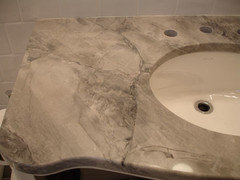
betsyhac
12 years agolast modified: 9 years agoWow, this is very interesting and timely. I'm about to have some marble priced for me from yet another stone yard. The woman at the yard kept mentioning quartzite. I like the look, and if it's more durable and within my budget, may go for it. So, from what I read above, the best way to get past any mis-naming is to do the lemon test?
I'm not sure I understand the fabricator's statement below:
"Here in Chicago, I had fits with a white quartzite material called White Moon. The stuff was impossible to seal, but the problem wasn't the stone - it was the resin treatment."
Does this mean that once he tried a different resin treatment, he was able to seal the stone? "Had fits"???lisa0527
Original Author12 years agolast modified: 9 years agoI know...so confusing. Here's my understanding of the situation, and I welcome correction and clarification.
Once upon a time all stone sold as quartzite was actually quartzite. Gorgeous and durable, looked like marble...what could be better. Naturally, everyone wanted it, but supply from reputable and experienced suppliers was limited. So stone began to hit the market that was labelled quartzite, but maybe wasn't really "true". or "pure" quartzite. In fact, this new pseudo-quartzite had a lot of the problems that the true quartzite didn't. It was very porous and it etched when exposed to acids. So they began to coat the "quartzite" slabs with resin at the quarry. Made it look great, and at least temporarily prevented etching. Problem was, by filling the natural pores in the stone, the resin also prevented the sealant from being properly absorbed! So now this resined "quartzite" was hard to seal, and therefore prone to staining and then eventually etching as the resin wore off. I've even heard stories of thickly applied resin pealing off finished slabs!
There are still gorgeous slabs of durable, bullet proof quartzite out there, but it's buyer beware. Members on this forum seem to have either found it indestructible or very porous and prone to etching. I think the only safe option is to get a sample and test it out. I'm looking at some stunning slabs of White Pearl quartzite. The yard won't give me a sample, so I'm going to ask the fabricator to ask for one and have him test it out, to see if it can be sealed properly, and to see if it etches. It feels as if there's resin, but it sounds like that may or may not be a problem, so each slab is a unique case. If they won't give the fabricator a sample I don't think I'll be able to convince my husband to risk it...and I'll likely end up with quartz counters. Good luck and let us know how it turns out and what you learn.
colorfast
12 years agolast modified: 9 years agoI looked at some of these mentioned and my husband really didn't want to do a white. One other you have not mentioned is Glacier White. A member here emailed the idea to me and I went and saw it. It is really lovely. It is a granite, not a quartzite but has that same look. HTH
betsyhac
12 years agolast modified: 9 years agoOh Lisa, thx! That really does clear it up. Under those circumstances, it sounds like it will be too expensive, but I'll see what happens and definitely get a sample. So the Moon White in Chicago . . . was it actually a good stone, but with a bad resin? Had they not applied the bad, possibly temp, resin and, instead, fabricator was allowed to seal properly, it would have been ok?
sochi
12 years agolast modified: 9 years agoSounds like a good approach Lisa, good luck! I was able to get a sample of my quartzite before buying it, so was able to do the testing. I agree with your husband frankly - if they refuse to give a sample, you should refuse to buy it. Thanks for all the great info.
lisa0527
Original Author12 years agolast modified: 9 years agoFinally convinced supplier to give me a sample of the White Pearl Quartzite. He alos informed me (after 5 emails and lots of questions!) that quartzite requires 7 COATS OF SEALER, as opposed to 1 or 2 coats of sealer for granite. Given that some fabricators may not have a lot of experience with quartzite it's possible that this may explain why some have had real problems with their quartzite and others haven't.
I'll let you know what my fabricator finds...probably in a few weeks.Cloud Swift
12 years agolast modified: 9 years agoLisa, first off, one can't make a general statement about quartzite being porous. Some like ours isn't porous - our fabricator did one coat of sealer and based on the test I did on a sample, it probably didn't even need that. It's been used for 5 years with no resealing and even dried on spills wipe up cleanly.
Secondly, I doubt that anything benefits from more than a few applications of sealer. One isn't building up a coating with it - if there is a build-up of excess sealer, that causes its own kind of cloudy water marks. One is just filling in the pores. One might not get enough sealer on in the first application to fill them all up if the stone is very porous, but I don't expect that it would take any more than another application or two to get it all.
lisa0527
Original Author12 years agolast modified: 9 years agoI agree with you...I think it was a very bizarre statement he made about 7 coats of sealer! I think the truth is that they just don't know very much, if anything about quartzite at this yard, but they're the only ones it town that have it. I'm glad they've finally agreed to give me a sample and I'll just have the fabricator test it out to make sure it can be sealed properly. That and an etching test should satisfy my husband, I hope. What type of quartzite did you use and do you know what sealer your fabricator used?
Cloud Swift
12 years agolast modified: 9 years agoI think you are right about the knowledge at the yard Lisa. It is fortunate that testing the sample should tell you what you know.
I didn't mention the name of my stone because it isn't one of the white or gray marble look-a-likes that the folks on this thread want. It's Azul do Mar and, true to its name, it looks like the ocean. It has some small white areas and they are trouble free, but it is mainly aqua and blue with some brown bits and a lavender gray current in one part of the stone.
I haven't seen anyone having porosity or etching problems with the colorful ones: Azul Macauba (which usually has a lot of white with aqua to blue veining), Wild West Green, Van Gogh and such. The findstone test data says that Azul Macauba is very low porosity and mine (which comes from a quarry near there) also seems to be. Since our unsealed sample didn't absorb anything, I didn't pay attention to what sealer they used. I was out of town on business when they did the sealing.
Here are some photos of ours (Some time I should take new pictures now that the fridge has been replaced with a stainless steel one):
padmae
11 years agolast modified: 9 years agoWe have Quartzite Bianca and it is very porous.. took a few weeks for it to go from gray to white because of the water it soaked in from fabrication. What I was told by a stone guy was what etches in any stone (marble, limestone, etc.) is calcite reacting to an acid. He said quartzite (true quartzite) should not etch since it does not contain calcite, however, some (cheaper) resins being applied to slabs are reacting to acids causing etching in typically non-etching stones. Some posts about quartzite and even some granites such as Absolute Black, said these are such dense stones that sealer can't penetrate and sits on the surface. I sure don't know, and am not sure why, given a typically porous stone such as quartzite, why it wouldn't absorb the sealer.. but it might explain why our newly installed/sealed counters have a film on them. Our fabricator recommended a one-time use of windex and/or using a scrubbie, but I'm hesitant to use windex even once. Maybe use acetone to strip the sealer and start over with a different sealer?
islanddevil
11 years agolast modified: 9 years agoSo confusing which is why I need to save this useful thread.
Cloud Swift- your quartzite is amazing! I didn't even know those colors existed in quartzite. Can you please post the link to your kitchen reveal...if you posted one? Thanks.
karin_mt
11 years agolast modified: 9 years agoGoodness! This revived thread points out the marble vs quartzite confusion has been going on for quite some time. I did get a big kick out of the post by Aliris who makes the case for using actual rock names instead of conflating them all as granite.
As for the original question about the porosity of quartzite, it depends on the degree of metamorphism. Cloud Swift spoke to that early up in this thread. Quartzite starts out life as quartz sandstone which can be very porous. During metamorphism those pore spaces get squeezed closed. Metamorphism isn't a black and white process - a rock can be just a little bit cooked and can still have pore spaces. This is what's going on with the porous quartzites. But if the rock is exposed to a high degree of metamorphism it won't have much porosity left between the grains. Of course it could still have fractures which are another type of porosity (properly called 'secondary porosity,' if you'd like to have a $10 term to throw around at the slab yard).
So yeah, porosity in quartzite does vary, and yeah, the debate over inane practices in stone nomenclature lives on!
Nicole
10 years agolast modified: 9 years agoI was told (by the only stone yard owner I trust) that the "quartzite" moon night granite, or any of the ones that look like they have "boulders" are granit and NOT quartzite.
Also, the stone almost always is polished AT the quarry, then shipped over. That is why honing, leathering, wire brushing, etc. is an additional expense.
I have true honed quartzite (they called it white Macuba) it is completely smooth-as honed marble is. It was initially sealed but most of that is gone since I use a "lemon" cleaner. I have never had a stain that the scrub side of my sponge couldn't get out. And I have no intention of ever reselling.
Also, I regularly put hot pans directly on the counter. No issues whatsoever.
My advice is that if they insist it be sealed, it most likely is not quartzite. Ask for a sample (broken piece). By the way, if its real quartzite they probably won't be able to give you a broken piece because it is very difficult to break. But they might have a remnant left over from another job. Take it home and test it with a slice of citrus. Then you will know form sure.
karin_mt
10 years agolast modified: 9 years agoUmmm, your stone yard owner is incorrect, sorry. The rocks that look like "boulders" are not granite. They are breccia ("brech-ee-a"). Breccia is a rock made up out of angular fragments that are stuck together in a solid mass. Breccia can be made of quartz, limestone, marble, or other rock types. Breccia and granite are entirely different classes of rocks.
Some quartzites really do benefit from sealing, so a recommendation that the stone be sealed does not mean it's not quartzite. You are totally right though that a sample is the way to go. In addition to the lemon test you will also want to do the glass test. Quartzite will easily scratch glass and marble will not.
Macabus is probably my favorite of all countertop rocks. Lucky you!
brickeyee
10 years agolast modified: 9 years agoStone cutters are not geologists, and for the most part do not need to be.
Just get a sample piece and do some testing before committing.
Water, kitchen oils 9they may not all behave the same, especially if some are hot when applied), acids foods (even actual vinegar), ketchup, mustard, just about anything you can think of for use in the kitchen.
Many of the more 'decorative' stones are mixes of types and different portions of the stone may respond differently.
That 'inclusion' that makes a pretty swirl may be a completely different type of stone (or mineral) in geological and chemical terms.
Cloud Swift
10 years agolast modified: 9 years agoIsland, my kitchen was finished over 6 years ago so my kitchen reveal thread has probably aged off. I've put the link to the reveal of the familyroom redo we completed more recently which has some pictures of the kitchen.
Quartzite is mostly composed of quartz which is clear or translucent whitish. That allows trace minerals to give it some pretty bright colors. The quartzite people have been posting about a lot recently in gardenweb is the more marble look white and grey stuff, but when we were doing our kitchen there was more of the colorful stuff: Azul Macaubas, Blue Louis/ Van Gogh, Wild West Green. I once saw a slab that looked like Azul Macabas except violet instead of teal/blue and in retrospect I wonder if that was also quartzite.
Here are a couple of pictures of the kitchen: (taken when the new floor was put in as part of the family room remodel - the cherry toe kick covers haven't been put back on yet in these pictures)
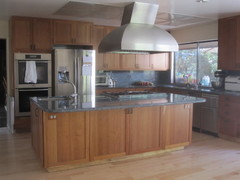

Here is a link that might be useful: Family room redo thread
cambridgehouse
6 years agoI want to go a kitchen countertop with Azul Macabus and was wondering how yours has held up?

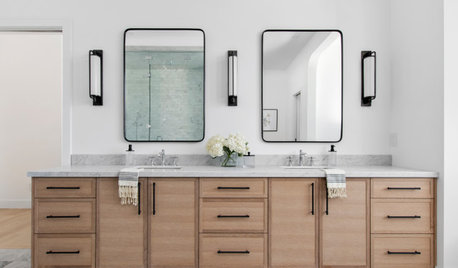
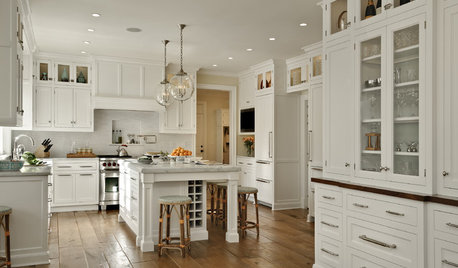
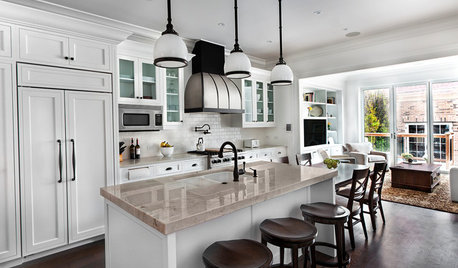
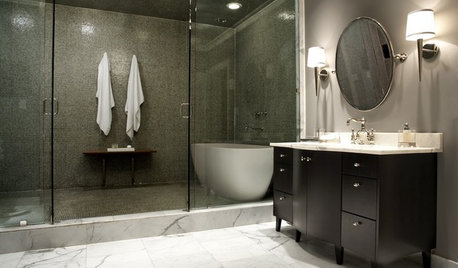
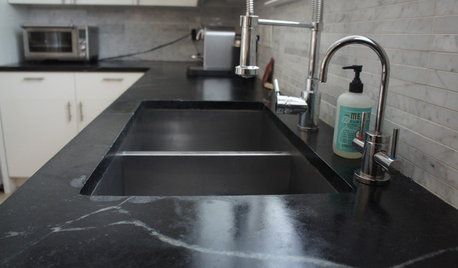
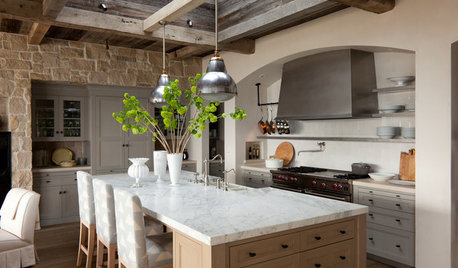
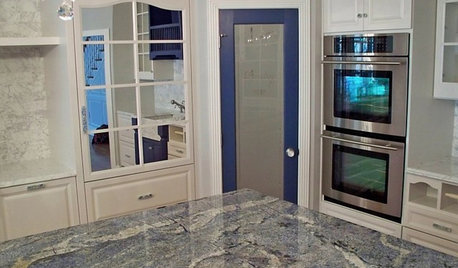

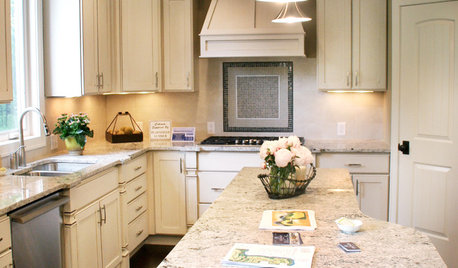






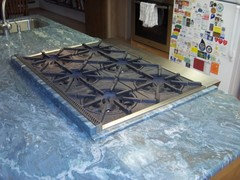
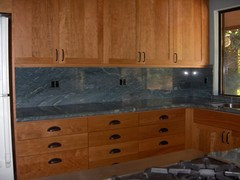




Stoneshine